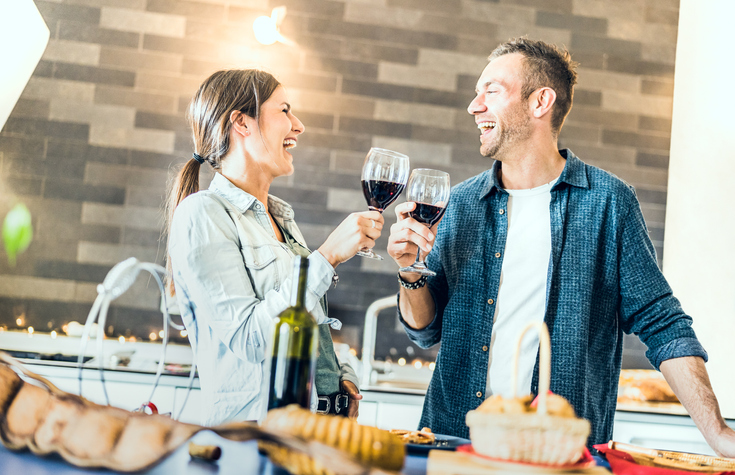Calling on the expertise of four wine specialists, including Dean Spencer, Chris Walkey, Douglas Blyde and Neil Crammies, our in-depth guide to arranging an at-home wine tasting gives people the help and insight they need to host a successful tasting – either in person or via video chat. We’ve covered the basics of how to taste wine and determine a good variety, as well as practical guidance on planning and preparing a tasting at home for friends and family.
The guide covers four key areas to hosting a wine tasting, which we take a look at below.
Understanding the basics of wine tasting
Arming people with the skills and knowledge to taste wine effectively at home was our first priority. Here, Douglas Blyde provides a four-step process for wine tasting:
- Look – at the clarity and colour of the wine to determine its quality, ripeness and age.
- Swirl – swirl the glass to aerate the wine, release the aromas and study the ‘legs’, which show its alcohol and sugar content.
- Smell – smell the wine pick up on the three types of aromas, including primary, secondary and tertiary.
- Taste – sip the wine to coat the mouth and examine the flavours, which include sweet, sour, salt and bitter notes.
Planning and preparing an at-home tasting
Some preparation is needed when hosting a wine tasting at home, especially if you’re planning to do it via video link. We asked our panel of experts to share their tips for organising a successful tasting – from serving to glassware.
Here, Dean Spencer shares his ideas on how people can decide on a theme for their wine tasting, which can help the event to run more smoothly:
- Compare similar grapes from different regions
- Challenge tasters with less well-known grapes
- Concentrate on a specific country or region
- Theme it around a specific future event
- Try a blind tasting
How the wine is served can also have a big impact on the overall experience, especially when it comes to glassware and temperature. Chris Walkey, who hosts specialist tastings and events, offered his advice on getting service right:
- Make sure that the wine is chilled and ready to be served at the recommend temperature.
- Serve wines in quality glassware and certainly do not use flutes for sparkling wines.
- Have a glass for each wine being tasting.
- Provide spittoons and also water.
- Have a sheet of plain white A4 paper so people can easily look at the colour qualities of the wine.
- It’s also nice to have prepared a list of the wines that are being tasted along with their details such as grapes used, vintage etc.
How to determine a good bottle of wine
Sourcing wine is one of the most challenging aspects of hosting a wine tasting at home, with thousands of varieties to choose from at different price points. Here, our experts each share their top tips on sourcing good wines for a home tasting:
- “As a guideline, you should look to spend somewhere between £8-£18 pounds a bottle (with maybe 3 to 6 wines to taste). If you consider that with a £5.99 bottle of wine only 37p is actually spent on production of the wine, it’s clear that you really need to be spending a little more. But as most of the costs in a bottle are fixed, you don’t have to step up too far to ensure much more is spent on production of the wine itself.” – Dean Spencer
- “Good white wines should have the requisite tastes associated with a certain variety, as should reds. Sauvignon Blanc should have gooseberry notes (Loire Valley) and maybe some exotic fruits (New Zealand). Riesling can carry lime zest initially and as they age, they develop some petrol notes. Good Chardonnay will show white peaches. Cabernet Sauvignon will have blackcurrant at its heart, while Syrah will have spicy blackberry fruit.” – Neil Crammies
- “Depending on the styles of wine you wish to have at your tasting, average prices can vary tremendously. What I would say is that if you want to show the qualities of wines then try and not go for the cheapest options, and instead look at specialist wine sellers either via the high street merchants or dedicated online wine shops. You are not likely to get a great idea of wine quality by purchasing cheapest options from the supermarkets. I would say £15 to £30 a bottle will be the ideal price range for most style of wines you should be aiming for.” – Chris Walkey
- “I really enjoy comparing wines made from the same grape across a few territories, such as the often petrol-scents of light-in-alcohol German Riesling, reaped from vines tugging into the vertigo-inducingly steep slopes of the Moselle River Valley, with a Riesling from Australia’s generally warmer Barossa valley; those wines can often be more about lime flavours – sometimes stingingly so.” – Douglas Blyde
Wine pairings
Many people will look to pair nibbles with their wines; it creates a sense of occasion and helps keep things fun and informal. Chris Walkey is a fan of food and wine pairings, suggesting: “Wine tasting can be quite thirsty work and it can be good to break up a tasting with some foods. Note that not all foods pair with wines and each wine will usually have a recommended food type to pair with it. To be safe, many cheese varieties pair very well with wines from red sparkling to dry still whites, though try not to have smelly cheese, as this will affect the ability to appreciate the wine aromas!”



